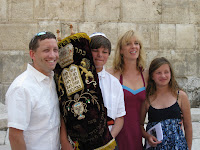
I had the pleasure of spending this morning with
Rabbi Gedaliah Druin, a sofer, while he checked and repaired some of our temple’s Torah scrolls and led a study session with about 20 adults. I learned some new and important insights from him: The Torah is not a book, we do not read it, and a scribe does not write. The Rabbi explained that the service for publicly reading the Torah is called “
kriyat ha-Torah” which literally means “the CALLING of the Torah.” We use the Torah for calling – calling God, our ancestors, and our deepest held values. Accordingly, the Torah is an instrument or a tool – like a phone. Rabbi Druin reminded us: Don't forget to make a call when you next take out the Torah. Then, as if on cue, his son called from Florida on his cell phone (Rabbi Druin held it up and asked us all to yell “Shalom” – that would let his son know that he was okay).
Before he fixed the small Torah scroll for us – one letter in the Joseph story needed to be repaired – Rabbi Druin wanted to make sure we knew that he was not going to write. In fact, he doesn’t write Torahs. He explained through some stories. First, Moses spent forty days atop Mount Sinai learning to form letters. It was the creation of the first alphabet and God taught it to Moses so he could create a Torah. Second, when the Jews returned from the Babylonian exile, they were led by…. a scribe named Ezra! Finally, Rabbi Druin reminded us that Genesis says God created the universe through words. We weren’t about to simply fix a letter. We would create a universe (like Genesis), lead Jewish redemption (like Ezra), and stand atop Sinai to commune with God (like Moses)… all that in a few minutes in our temple social hall!
In that vein, Rabbi Druin then explained that the ink he used was not, in fact, ink. It was liquid darkness. Just like in the creation story, we needed to combine darkness and light. The liquid darkness would be applied to the parchment, which is made of animal skin. Animal skin in Hebrew is called “
OR” which is also the word for “light.” As Rabbi Druin explained, “the white part of the Torah is the soul and the black part is the body. When I make the Torah I have to put these together with such care. We can transform these things into something great.” The whole idea of Torah is to create reality and to change reality. He then made a simple blessing before putting body to soul. His only intention was that it would work.
He made a tiny stroke, an upside down
Yod that transformed a
Dalet back into a
Hay so the word “
Hinei” again emerged where “
Dinah” had sat for the past few years. It was just a letter – actually only a piece of a letter. But the power of it was so much greater. Rabbi Druin explained: letters are called “
OTIOT” in Hebrew. That word appears in a crucial description of the Exodus: God brought us out of Egypt with “
MOFTIM” (Great Wonders) and “
OTIOT” (“letters”?!). Could it really be possible? Did God really take us out of Egypt with letters? It must mean something else… something like “miracles.” Whether you believe in the Exodus story or not, the language is powerful.
OTIOT are
OTIOT. God took us out Egypt using them and Rabbi Druin produced one in the social hall today.
It was a heck of a morning and I wanted to share with everyone. You can bet I made a lot of calls.


(Thanks to Rich Sachs for the photos - click them for a close up)

















